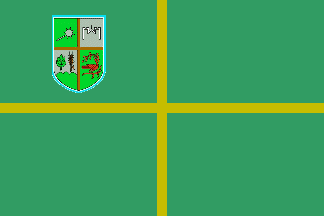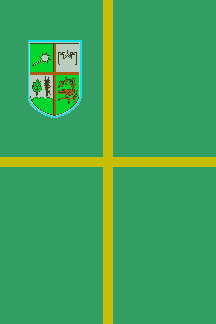
by Istvan Molnar, 4 December 2000

Last modified: 2002-11-02 by dov gutterman
Keywords: hungary | gyor-moson-sopron | papa | veszpremvarsany | bakony | zirc | mace | corn | leaf | church |
Links: FOTW homepage |
search |
disclaimer and copyright |
write us |
mirrors

by Istvan Molnar, 4 December 2000
See also:
Veszprémvarsány is a village in Veszprém County in Hungary
near to Town of Pápa (36 km east) on the border of the
Little Hungarian Plains and the Bakony Mountains. The village has
got 1.080 inhabitants (1990 census), nearly all of them are
Hungarians. Neighbouring settlements are: Lázi, Románd,
Bakonygyirót, Bakonyszentlászló, Bakonyszentkirály, Réde and
Sikátor villages. In 1910 Veszprémvarsány was a village in the
Zirc district of Veszprém County. Number of inhabitants in 1910:
1.398; 1.358 (97,1%) Hungarian, 39 (2,8%) German and 1 (0,1%)
others by mother tongue, 870 (62,2%) Roman Catholic, 401 (28,7%)
Lutheran, 94 (6,7%) Calvinist and 33 (2,4%) other by religion.
Istvan Molnar, 4 December 2000
Veszprémvarsány village joined Gyor-Moson-Sopron county on
20th October 2002.
Istvan Molnar, 31 October 2002

by Istvan Molnar, 4 December 2000
gm-vy.gif)
by Istvan Molnar, 4 December 2000
Description of the CoA: The first and the fourth fields are
green, the second and the third fields are silver. In the first
field there is a mace relates to the Protestant inhabitants of
the village, in the second field there is a silouette of the
Roman Catholic church relates to the Roman Catholic settlers, in
the third field there is a corn and a leaf relate to the
agriculture, the three hills relate to the three hill of the
village (Herceg (Prince), Köveshegy (Stony Hill), Ebédlátó
(Lunch-Seeing)) and the three county bordered the village. In the
fourth field there is the old seal of the
village.
Istvan Molnar, 4 December 2000
gm_vy.gif)
by Istvan Molnar, 4 December 2000
The village uses the old seal from 1788.
Istvan Molnar, 4 December 2000